
Learning Download: Instructions for Growing Peas
From Seed to Harvest: A beginner’s guide to growing peas.
Peas are a fun plant to grow with different varietals allowing gardeners to eat the whole pod or split the shell open to find bursting peas inside. Depending on the species, peas can be grown in a pot or in a garden, which makes the pant a good option for all green-thumbs. Peas are a cool-weather vegetable, meaning they flourish in the spring and fall months. The two main different types of peas are shelling peas and edible-podded peas. Shelling peas are grown for the peas hidden inside the pod. Once shelled, discard the pod. Edible-podded peas can be eaten whole, pod and all.
To plant:
Seeds can be sown outdoors four to six weeks before the last spring frost. Prior to sowing, add wood ashes to the area for fertilization. Soak seeds overnight and plant them an inch deep and two inches apart. If you are planting in an area with wet soil, it is encouraged to use raised beds as the seeds may rot in soil that isn’t well-drained.
Some species of peas may grow in a vining pattern. If you are planting one of these species, establish a trellis or plant cage at the time of planting. if desired, sprinkle rhizobium bacteria powder on the seeds prior to planting, as peas are legumes that require the bacteria to grow well. For fall crop, add more compost prior to planting to allow for a cooler soil during the warm end of summer. Plant them when the air temperature is 75 degrees or cooler on average.
To grow:
Too much fertilization may harm peas, as they are vulnerable to nitrogen. Compost may help, though pea plants don’t need much fertilizer. Water the plant sparingly and don’t hoe the area as this may damage roots. Weed the plants by hand. Adding mulch, grass clippings or other materials will prevent weeds from growing, but ensure the mulch doesn’t touch the pea plant.
To harvest:
Peas can typically be harvested between 12 and 15 weeks after planting. Rotate your pea crop every other year. Continuously pick the pods to encourage more growth. When picking, secure the vine with one hand while using the other hand to pinch the peas off the vine. Peas are ready for harvest when the individual peas are barely larger than the planted seeds.
What peas crave:
Peas desire an open, full-sun area to best grow in, also requiring well-drained soil between pH measurements of 6 and 7.5. They do best in temperatures of 55 to 65 degrees Fahrenheit.
Where to buy pea seeds:
You can find many species of peas seeds, from sugar sprint to spring peas at Urban Farmer.
Learning Download: Common pests and diseases: Peas
Common pests and diseases: Peas
When growing vegetables, it is always exciting to care for the plant throughout its growing phase and then harvest it for delicious recipes later on, but one thing to watch out for is pests and diseases. Different plants are susceptible to different types of pests and diseases, and it is important to make yourself aware so you can keep a watchful eye and also take any preventative methods to keep your plants safe throughout their lifespan.
Peas can fall victim to several pests and diseases.
Pests:
Some of the common pests affecting pea plants include aphids, leafminers and the Mexican bean beetle.
Aphids will be soft-bodied insects usually showing up on the undersides of the leaves. They will be green or yellow in color. The aphids secrete a sticky substance which can cause mold. Knock the aphids off the leaves with a jet of water. Only use insecticides if the infestation is out of control.
Leafminers can create white splotches on the leaves and the leaves will fall off the plant. If the leafminers infect the plant when it is young, it can reduce the plant’s yield. Remove plant debris from the soil immediately after harvest to prevent this, and use insecticides once the damage is identified.
The Mexican bean beetle will cause irregular groups of feeding on the bottom of the leaves, which causes the top surface of the leaf to dry out. Brush the eggs off the leaves and apply an insecticidal soap.
Diseases:
Some of the common diseases affecting peas include brown spot, downy mildew, fusarium root rot and gray mold.
Brown spot will cause water-soaked spots on the leaves, and after a few days the lesions turn tan and resemble a scorch instead of a water-soaked spot. Leaves experiencing this may dry and drop from the plant. To manage this issue, plant only disease-free seeds, rotate crops and don’t plant peas in the fall.
Downy mildew will cause yellow or brown blotches on the tops of the leaves and a fluffy-white growth on the bottom. The plant may be stunted or distorted, and the whole plant may even die. To avoid this problem, practice crop rotation, plow the crop debris into the soil and don’t plant peas in late August.
Fusarium root causes the plant to yellow, have stunted growth and have dark streaks on the roots. There are no resistant varieties yet, so practice crop rotation and apply appropriate fungicides prior to planting.
Gray old will cause fuzzy gray lesions on the stem, which can girdle the stem and cause the entire plant to wilt. Lower leaves may also be covered in the fuzzy gray lesions and can shrivel. A potassium deficiency may make plants more resistant to this disease. To prevent the disease, apply the appropriate fungicides if the plant begins flowering in wet conditions.


